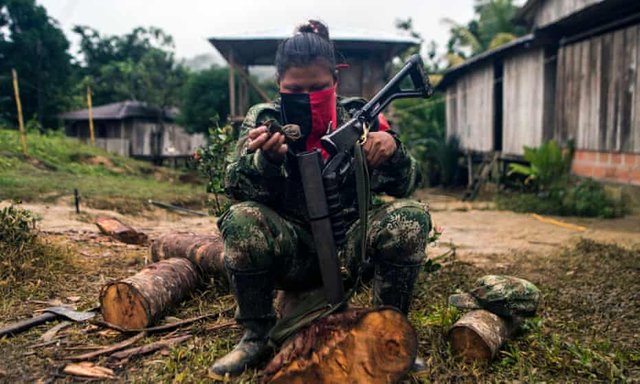Colombian rebels blamed for killing spree 400 miles inside Venezuela

When Nassif Suliman’s daughter Adela left their home in Tumeremo to pan for gold in the wildcat mines in Venezuela’s southern jungle, he feared she would not return.
So when news came that foreign rebels had committed a brutal massacre in the region, Suliman, grey-haired and bespectacled, joined the military in a harrowing search for bodies.
“It was a normal walk until I saw bloodstains, and then just by a shrub 500 metres from the main road, I saw her body, all bloody and bruised,” Suliman said, his voice quivering. Adela had been shot in the head.
Over three days from 14 October, at least seven miners were murdered near Tumeremo, in Bolívar state, the heart of Venezuela’s so-called “mining arc”.
Life's a struggle as Venezuela inflation heads for one million per cent
Read more
Mining in the region had always been a dangerous vocation: the mines were controlled by violent local mafias which operated with impunity.
Now, however, a leftist guerrilla group from neighbouring Colombia is expanding in the zone, and leaving dead bodies in its wake. Victims’ families say that the National Liberation Army (or ELN) was behind the massacre which took place 400 miles from the Colombian border.
Advertisement
The rebel group have long operated along the frontier between the two countries, but the recent massacre suggests their reach extends deep inside Venezuela, as they muscle in on the lucrative informal goldmines.
“The guerrillas did this,” Suliman said.
Oil-rich Venezuela is mired in economic turmoil with rampant hyperinflation and widespread shortages of basic goods. Over 2 million people have fled the country where a kilo of meat is more expensive than the average weekly salary.
For many of those who remain, clandestine and informal gold and coltan mines offer a way to make a living – at great risk.
“Everyone who goes into the mines is scared,” said José Pacheco, a miner from the region. He initially worried that his daughter had also died in the massacre, though she turned up alive a few days later. “You never know if they will come out … now with guerrillas there it’s even worse.”
Venezuelan officials deny the presence of ELN guerrillas in Bolívar, but locals say that living among the rebel army is a fact of daily life.
“The rebels want to take control of all the mines, lashing out at innocent miners who are just working so they can eat,” said Jenny Mota, a resident whose niece sells cigarettes and snacks to miners. “My family all say that they are guerrillas and that they are Colombian.”
Colombia’s conflict, which began in 1964, has left at least 260,000 dead and more than 7 million displaced. The military and state-aligned paramilitaries contributed to the violence.
The country’s largest rebel group, the Revolutionary Armed Forces of Colombia (or Farc), demobilised following an accord reached in late 2016, though that process has been fraught with defections and killings of activists who support the deal.
The ELN had been in stop-start peace talks with the Colombian government, though those talks recently stalled.
Colombian rebels have long used Venezuela as a strategic rearguard, with security forces willing to turn a blind eye. Amid doubts over the fragile peace in Colombia, the ELN and Farc dissidents who chose not to lay down weapons have taken advantage of the chaos in Venezuela, to expand their presence deep inside the neighbouring country.
Farc deal opens path for Colombia's other rebels: 'The future has to be about war'
Read more
Venezuela’s mining arc stretches across the country from the Colombian border to the frontier with Guyana, and has long been a byword for lawlessness and violence. Soldiers killed 18 people in the region in February. Last year, a skirmish between rival gangs left 17 dead. Over the past two years, an estimated 107 people have been killed in massacres in Bolívar state.
Advertisement
Now, with the bellicose ELN staking their claim on the territory, the situation for locals is deteriorating.
Bram Ebus, a consultant for International Crisis Group and investigator for Infoamazonia, a website that monitors the Amazon region, said that the rebels are looking to establish themselves as the main presence in mining arc. “They are in it for the long haul,” he said.
“By taxing illegal gold and coltan mining operations the guerrillas are collecting hefty sums of money with little respect for human rights,” Ebus said, adding that many massacres go unreported as locals are too afraid to speak out.
Américo de Grazia, a prominent opposition politician in Venezuela, claims that despite the government’s silence, Nicolás Maduro and his cronies are aware of the ELN’s presence. “Silence gives consent. They know that it is true. They know that the ELN is operating in Bolívar state,” he said.
Hi! I am a robot. I just upvoted you! I found similar content that readers might be interested in:
https://www.theguardian.com/global-development/2018/oct/30/venezuelans-say-colombian-rebels-to-blame-for-killing-spree-in-mining-zone